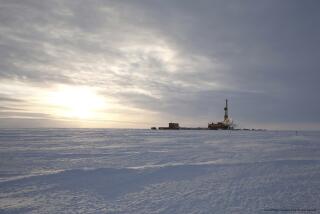In Alaska, Dead Moose Are a Boon to Charity
ANCHORAGE, Alaska — The moose calf loitered near its dead mother when Billy Dickerson Jr. and his nephew arrived to collect the carcass.
Dickerson and Cody Dyer parked their pickup truck near the sports center of Alaska Pacific University, in midtown Anchorage. Then they trudged through deep snow and dense woods behind the complex, heading uphill toward the dark form of the fallen cow. Startled, the calf bolted.
“I think it’s big enough to survive winter,” Dickerson said of the calf. He then turned his attention to the work at hand--salvaging the meat for charity.
It’s an act repeated hundreds of times each year.
Alaska Fish and Wildlife Protection Troopers coordinate a road kill program that puts moose meat on the tables of poor Alaskans. Nonprofit groups, including churches, sign up to take turns collecting the remains of animals hit by cars and trains. Under the program rules, they must give the meat away to anyone who asks.
Other states have road kill programs, but primarily for smaller animals like elk and deer, not moose, which can weigh half a ton or more. Maine is among the few Lower 48 states with moose and does give motorists first right to road kills, then donates unwanted animals to the needy.
Charity takes priority in Alaska, where vehicles kill about 700 moose annually and trains kill about 120 a year. Those averages put the state behind only Sweden, where 4,000 to 6,000 moose are road casualties each year, according to the Alaska Department of Fish and Game.
Often, traffic collisions only maim moose, so authorities must shoot the animals. In the Anchorage area, that job frequently goes to Fish and Game wildlife biologist Rick Sinnott, who shot the university moose after it was seen limping around the school grounds.
A trooper dispatcher then called Dickerson, 41, whose name was next on the contact list as a representative of the Anchorage Baptist Temple.
“This isn’t for everyone,” Dickerson said, tying a nylon rope around the dead moose’s neck.
A lifetime hunter, Dickerson estimated the 1,100-pound animal would yield 700 pounds of meat. But first, he and 14-year-old Cody had to figure out the best route to drag it through 300 yards of spruce. Otherwise, they’d be forced to cut it outdoors, not a pleasant prospect with the temperature at 15 degrees above zero and dropping as the sun set.
Dickerson was undaunted by the possibility, even though he was dressed only in a T-shirt and slacks. Field dressing a moose in bitter cold releases a gush of steam that generates a lot of heat, he said.
By this time, his father, Billy Dickerson Sr., had pulled into the university parking lot with Cody’s brother, Tyler Dyer, 19. The elder Dickerson’s task was to pull the animal to his truck with a winch.
In the woods, Billy Dickerson Jr. and his nephews tugged hard on the rope. A half hour later, the moose was securely in the bed of the truck. Next it would be butchered at Dickerson’s house, then donated to the Anchorage Rescue Mission.
To spread the bounty, troopers run the road-kill program in the Matanuska-Susitna Borough, Fairbanks and the Kenai Peninsula, said Eileen Brooks, program coordinator for the Anchorage region and the Matanuska-Susitna Borough.
“It gives more folks a chance for free meat,” said Brooks, known among colleagues as Queen of the Gut Pile. “A lot of people can’t afford to buy steaks or even hamburger, at least judging from the calls I get.”
Brooks said 99 nonprofit organizations are signed up this winter in the area she manages.
Among them is Abbott Loop Community Church, a two-decade participant that averages 10 moose a year, according to member Steve Tandy. The meat is distributed through a community food pantry at the church.
“We always have lots of moose available to whoever wants it,” Tandy said. “We never turn anyone away.”
Participants occasionally are called to salvage black bears, Dall sheep or mountain goats, Brooks said. But the great majority of collisions involve moose. In Brooks’ jurisdiction alone, 151 moose were killed between Oct. 1 and Dec. 14. That’s above average for this time of year, she said.
Sinnott, with Fish and Game, said he’s shot more injured moose than usual in Anchorage this winter. Since Sept. 1, he has put down 20 moose, compared with an average of 15 for an entire year.
Sinnott attributed the rise on increasing moose numbers in the municipality--about 1,900--a 17% jump from two years ago, but still far below the 1994 record of 2,200. Sinnott said the fluctuating population is due to an irregular cyclical pattern dependent on such factors as winter survival rates and snowfall levels that can drive more moose into urban areas.
“It makes sense that the more moose you have in town, the more people are going to hit them,” he said.
More to Read
Sign up for Essential California
The most important California stories and recommendations in your inbox every morning.
You may occasionally receive promotional content from the Los Angeles Times.










